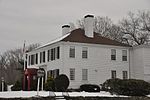Maples Cottage
1830 establishments in MassachusettsBuildings and structures in Westborough, MassachusettsHistoric district contributing properties in MassachusettsHouses completed in 1830Houses in Worcester County, Massachusetts ... and 3 more
Houses on the National Register of Historic Places in Worcester County, MassachusettsNRHP infobox with nocatWorcester County, Massachusetts Registered Historic Place stubs

Maples Cottage is a historic cottage in Westborough, Massachusetts, USA. Located on the former grounds of the Lyman School for Boys, this Greek Revival cottage was built in 1832 by Rev. William White on the site of a 1725 parsonage. The property was acquired by the state in 1884, and used as part of the reform school, which is now closed. The building has lost most of its exterior Greek Revival styling (see photo). The cottage was listed on the National Register of Historic Places in 1980, and included in the historic district encompassing the Lyman School in 1994.
Excerpt from the Wikipedia article Maples Cottage (License: CC BY-SA 3.0, Authors, Images).Maples Cottage
Oak Street,
Geographical coordinates (GPS) Address Nearby Places Show on map
Geographical coordinates (GPS)
| Latitude | Longitude |
|---|---|
| N 42.285555555556 ° | E -71.627222222222 ° |
Address
Oak Street 154
01581
Massachusetts, United States
Open on Google Maps









